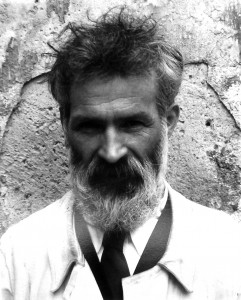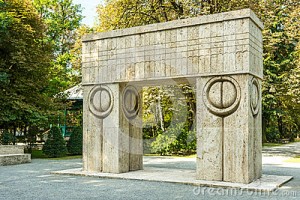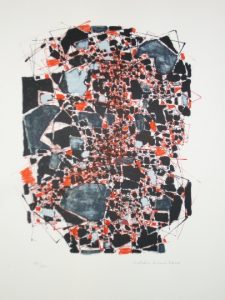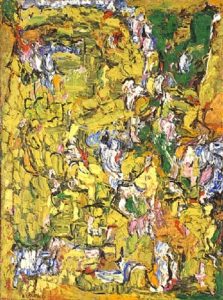PEOPLE I MET – Nathalie DUMITRESCO & Alexandre ISTRATI
(a Visit to the original Brancusi’s atelier in Impasse Ronsin, Montparnasse)
Natalia Dumitresco (1915-1997) and her husband Alexandre Istrati (1915-1991) are both Romanian-born abstract painters of the Ecole de Paris, further known as testamentary legatees of sculptor Constantin BRANCUSI (1876-1957).
I first met these artists at the Proceedings of the “First International Constantin Brancusi Symposium” in Romania, in the mid 1960s, when they impressed me as a low-key, almost self-effacing guests, among so many participants, from all over the world, who were vying for prominence and attention.
The “Constantin Brancusi Memorial Symposium” held in Bucharest was followed by a visit to Targu Jiu, focussing on the monumental ensemble of the Gate of the Kiss, the Table of Silence and the Column of Infinity. At this signal event I had the particular privilege of escorting the Symposium’s participants on their visit to Targu Jiu. During this latter part of the visit I must have made a certain
impression, on both Istrati and Dumitresco, as they suggested that should I
ever go to Paris I ought to come and visit them. This prospect had hardly any chance of materializing, as the draconian restrictions imposed by Ceausescu
made most improbable any foreign travel and especially that beyond the Iron Curtain. Understandably, I did not think further about this invitation, although I found the suggestion as attractive as generous, yet beyond any realistic dreams.
Little that I anticipated as only a few years later, in 1968, on traveling through Paris on the way back to Romania, from a Symposium which I attended in England I remembered Nathalie Dumitresco’s earlier suggestion and I rang her, asking if the invitation was still standing. That was how I was asked to dinner in Constantin Brancusi’s old atelier. It goes without saying that I was elated beyond belief by this unique opportunity and was over the Moon for such privilege.
At this point one should remind the reader that only a few years after my visit, at the time of President Georges Pompidou (1911-1974), the Montparnasse neighborhood was demolished, the whole of Brancusi’s atelier was moved to a dedicated redesigned atelier near the Centre Pompidou, in Les Halles area of Paris and all that was left of the former location is a modest “Constantin Brancusi Square”, flanked by modern architecture.
Looking back at the dinner in Brancusi’s old atelier, the memories are like a replay of a magic dream. In the summer evening the narrow lane of Impasse Ronsin, now completely vanished, was deserted. As I rang the bell, I remember I was not a little surprised, that before I was let in, Istrati looked up and down the lane, I presume to check if I may have been shadowed by some unwanted troll… For the uninformed reader one should point out that Paris of the ‘60s to late 1980s was replete with cloak and dagger stories, which would have made Agatha Christies’ stories a child’s play: indeed, one could not be too careful: see http://www.romanianstudies.org/content/2009/04/romanian-destinies-in-the-times-of-london-obituary-monica-lovinescu/
A steaming golden polenta was de rigueur and I remember sitting around a scaled-down version of The Table of Silence – a memorable occasion engraved in my psyche ever since.
Years after this magic visit I attended several of Brancusi’s retrospectives, at the “Tate Modern” in London and at the “Musee d’Art Moderne”, in Paris, never being reconciled to the fact that the magic of the original artist’s atelier could ever be put together again. As for the latter, a new “Constantin Brancusi Atelier” was reconstructed in the grounds of the “Beaubourg Modern Art Museum”, in Paris, with the help and advice of both Dumitresco and Istrati.
During my postgraduate days, in Cambridge, I was privileged to meet a contemporary and old friend of Brancusi’s, the collector and art aficionado Jim Ede (1895-1990), who owned a “Prometheus Head”, as well as drawings by Brancusi. Jim generously lent me the original correspondence he had with the Romanian sculptor, who became a close friend and in whose memory he set up a “Constantin Brancusi Travel Grant”. This endowment, facilitated Cambridge Art students travels to see the artist’s sculptures, held in the Guggenheim and other American collections.
During various discussions held with several Cambridge dons and students I came to realize how little if anything was known about Brancusi’s Romanian roots and the symbolism of Romanian folk art within his oeuvre. This galvanised me publishing a few impressions, first in the “Cambridge Review” and then in the “Manuscriptum” quarterly Magazine, in Bucharest. Sadly, if predictably in retrospect, a so-called Romanian self-appointed art expert, of which there were many, contrived, without any reticence or self-respect, to appropriate the content of my communication, under his own signature, whilst this author was relegated to a mere footnote, for ”having so generously put at his disposal”, (oh, yes!) the manuscript sent to Bucharest… You have been warned!
Sic transit Gloria Mundi.
FOOTNOTE: For hose readers who may wish to find more detailed information, the Benezit Dictionary (Grund publ, 1999) contains valuable and extensive information on both Dumitresco and Istrati.









No Comments so far ↓
Like gas stations in rural Texas after 10 pm, comments are closed.